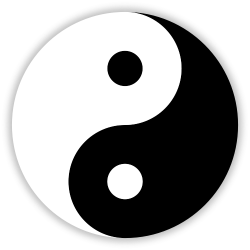Taoist Symbols
This page lists of the various symbols in the Taoist Symbols group.

Taoism (modernly: Daoism) is a philosophical and religious tradition that emphasizes living in harmony with the Tao (modernly romanized as "Dao"). The term Tao means "way", "path" or "principle", and can also be found in Chinese philosophies and religions other than Taoism. In Taoism, however, Tao denotes something that is both the source and the driving force behind everything that exists. It is ultimately ineffable: "The Tao that can be told is not the eternal Tao."
The keystone work of literature in Taoism is the Tao Te Ching, a concise and ambiguous book containing teachings attributed to Laozi (Chinese: 老子; pinyin: Lǎozi; Wade–Giles: Lao Tzu). Together with the writings of Zhuangzi, these texts build the philosophical foundation of Taoism. This philosophical Taoism, individualistic by nature, is not institutionalized. Institutionalized forms, however, evolved over time in the shape of a number of different schools, often integrating beliefs and practices that even pre-dated the k
Symbols in this group:
Jade
In purely monetary terms, jade doesn't always measure up to more desirable stones such as diamonds or rubies. On the other hand, when it comes to symbolic meaning, a rich history, and holding a revered place in diverse cultures, the readings for jade can truly shoot off the charts.
Lotus
In terms of symbolic importance, the lotus has achieved a status that has seldom been equaled by any flower. Its beauty, perfume and central place in many belief systems has made it a true monarch of the botanical world. It would be highly difficult to enumerate all the symbolic meanings of the lotus, so this article will provide a basic overview along with a few specific examples of cultures where the flower holds special significance.
Peach
Peaches hold an exalted status in Chinese culture, where they are strongly associated with the heavens and with eternal life.
Stag
When it comes to symbolism, the "stag" possesses a separate set of meanings from the “deer”, so this article will only address the former.
Yin and Yang
In Chinese philosophy, the concept of yin-yang (simplified Chinese: 阴阳; traditional Chinese: 陰陽; pinyin: yīnyáng), which is often called "yin and yang", is used to describe how seemingly opposite or contrary forces are interconnected and interdependent in the natural world; and, how they give rise to each other as they interrelate to one another.
Yin-Yang
In Chinese philosophy, yin and yang (also yin-yang or yin yang, 陰陽 yīnyáng "dark—bright") describes how opposite or contrary forces are actually complementary, interconnected, and interdependent in the natural world, and how they give rise to each other as they interrelate to one another.
Citation
Use the citation below to add this symbols group page to your bibliography:
Style:MLAChicagoAPA
"Taoist Symbols." Symbols.com. STANDS4 LLC, 2024. Web. 23 Apr. 2024. <https://www.symbols.com/group/30/Taoist+Symbols>.









Have a discussion about the Taoist Symbols group with the community:
Report Comment
We're doing our best to make sure our content is useful, accurate and safe.
If by any chance you spot an inappropriate comment while navigating through our website please use this form to let us know, and we'll take care of it shortly.
Attachment
You need to be logged in to favorite.
Log In